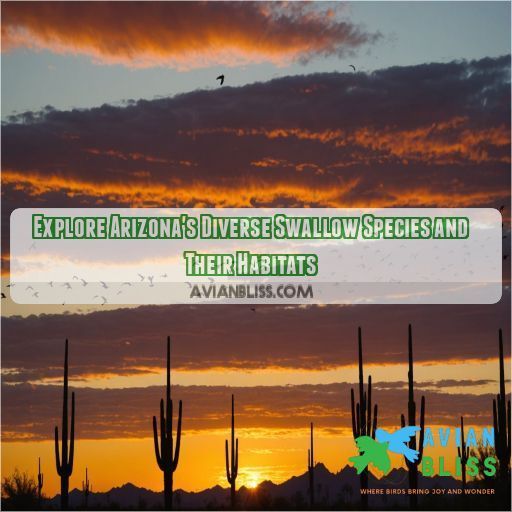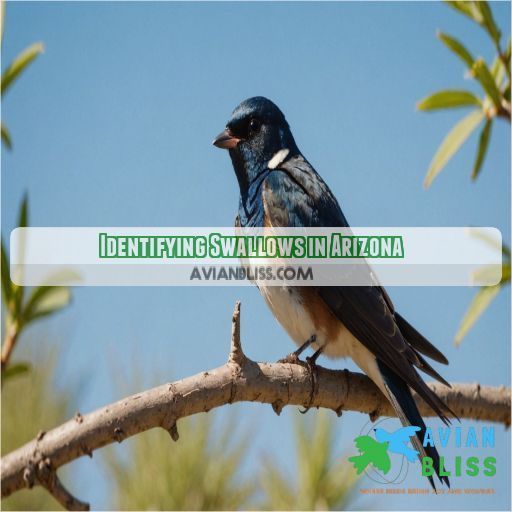This site is supported by our readers. We may earn a commission, at no cost to you, if you purchase through links.

These feathered aerial acrobats soar through the skies, delighting onlookers with their graceful loops and dives.
From the iconic Barn Swallow with its forked tail, to the Cliff Swallow with its distinctive white forehead, Arizona is home to a diverse array of these insect-eating wonders.
Whether you’re Birdwatching near a desert wash or marveling at the colonies under a highway overpass, you’re sure to spot these remarkable winged wonders.
And there’s so much more to discover about these aerial architects and their important role in Arizona’s ecosystems.
Shall we dive deeper?
Table Of Contents
- Key Takeaways
- Are There Swallows in Arizona?
- Identifying Swallows in Arizona
- The Ecological Value of Swallows
- Preventing Human-Swallow Conflicts
- Legal Status and Conservation Efforts
- Swallows in Arizona State Parks
- Frequently Asked Questions (FAQs)
- Are there swallows in AZ?
- How do you tell if a bird is a swallow?
- Are swallows good to have around?
- Do swallows return to the same place?
- How can I attract swallows to my backyard?
- What do swallows eat during the winter months?
- Do swallows form large colonies in Arizona?
- How can I differentiate between male and female swallows?
- Are there any rare or endangered swallow species in Arizona?
- Conclusion
Key Takeaways
- You’ll be wowed by the diverse array of swallow species soaring through Arizona’s skies – from the iconic barn swallow to the eye-catching cliff swallow. Keep your binoculars handy and get ready for an aerial acrobatics show!
- Swallows play a vital role in Arizona’s ecosystems, gobbling up pesky insects and serving as important environmental indicators. By learning to coexist with these feathered friends, you can welcome them into your backyard oasis.
- Explore Arizona’s stunning state parks to spot swallows in their element – whether it’s gliding over Patagonia Lake or nesting under the bridges of Dead Horse Ranch. These aerial marvels add an extra element of wonder to any outdoor adventure.
- You can help protect Arizona’s swallow populations by reporting your sightings to citizen science programs and supporting habitat conservation efforts. Every little bit counts when it comes to safeguarding these remarkable birds.
Are There Swallows in Arizona?
If you’re wondering whether swallows can be found in the Grand Canyon State, the answer is a resounding yes! Arizona is home to a diverse array of swallow species, each with its own unique characteristics and habitats across the state.
Common Swallow Species in Arizona
Arizona is home to a diverse array of swallow species that grace the skies year-round. From the striking barn swallow with its distinctive forked tail to the cliff swallow’s white rump patch, these aerial acrobats are a delight to observe. Keep an eye out for these feathered wonders as you explore the Grand Canyon State.
Seasonal Presence and Migration Patterns
Arizona’s skies come alive with the graceful movements of swallows as they migrate through the state. These aerial acrobats follow a seasonal pattern, gracing us with their presence at different times of the year:
- Soaring northward in spring to breed across the U.S. and Canada.
- Returning south in fall to their wintering grounds in Mexico and Central America.
- Adapting to changing climates, their arrival and departure dates may shift over time.
Habitat Preferences of Arizona Swallows
The diverse swallow species in Arizona thrive in a variety of habitats. Look for Bank Swallows near riverbanks, Barn Swallows around barns and buildings, and Cliff Swallows under bridges and cliffs. Purple Martins prefer nesting sites like specialized birdhouses, while Rough-winged Swallows can be spotted over open water. Each species has unique habitat needs that shape their presence across Arizona.
Identifying Swallows in Arizona
From the distinctive forked tail of the Barn Swallow to the white forehead patch of the Cliff Swallow, Arizona’s skies offer a diverse array of swallow species to delight birdwatchers. Learn how to identify each unique swallow by its plumage, behavior, and habitat preferences to enhance your outdoor adventures.
Physical Characteristics and Plumage Differences
Distinguishing Arizona’s swallows comes down to observing their unique physical features.
Look for the tell-tale tail shapes, wing patterns, beak sizes, and color variations.
Bank swallows have a brown chest band, northern rough-winged swallows appear brownish, and violet-green swallows boast iridescent plumage.
Barn and cliff swallows sport gorgeous blues and oranges.
Pay close attention to the head markings to identify these aerial acrobats.
Behavioral Cues for Swallow Identification
When observing swallows in Arizona, pay close attention to their flight patterns, nesting habits, and group dynamics. Swallows are masters of the air, swooping and gliding with effortless grace. Look for their distinctive feeding behaviors, as they skillfully pluck insects from mid-air. The birds’ lively vocalizations can also provide helpful clues for identification.
| Flight Patterns | Nesting Habits | Group Dynamics |
|---|---|---|
| Graceful gliding and swooping | Building nests on man-made structures | Foraging and roosting in flocks |
| Rapid, agile movements | Burrowing in riverbanks | Coordinated aerial displays |
Distinguishing Swallows From Similar Birds
When observing swallows in Arizona, it’s important to distinguish them from similar birds. Look for the swallow’s distinctive forked tail, sleek body, and graceful aerial maneuvers. Purple martins are much larger, while house finches have a thicker beak and hop instead of glide. Consult a bird identification guide to learn their unique features and behaviors.
The Ecological Value of Swallows
As you explore the diverse swallow species that call Arizona home, you’ll soon discover their immense ecological value. From controlling insect populations to serving as indicators of a healthy environment, these remarkable birds play a key role in the state’s vibrant ecosystems.
Insect Control and Pest Management
In addition to their ecological value, swallows are natural allies in insect control and pest management. Their voracious appetites make them effective predators of flying insects, including:
- Agricultural pests like aphids, beetles, and caterpillars
- Disease-carrying mosquitoes
- Crop-damaging flies
- Other nuisance insects
Contribution to Biodiversity
Swallows play a key role in maintaining Arizona’s rich biodiversity. As voracious insect consumers, they help control populations of pests that could otherwise overrun sensitive ecosystems. Their presence is a strong sign of the health and balance of local habitats, making them important indicators of environmental quality.
| Swallow Species | Insects Consumed | Impact on Biodiversity |
|---|---|---|
| Barn Swallow | Flies, moths, beetles | Balances insect populations, supports pollination |
| Cliff Swallow | Flying ants, bees, wasps | Prevents overgrowth of social insects, protects plants |
| Purple Martin | Wide variety of insects | Removes potential agricultural pests, maintains ecological equilibrium |
Indicators of Healthy Ecosystems
Swallow populations act as key indicators of a healthy ecosystem.
Their presence signals abundant insect prey, clean water sources, and diverse habitats – all signs of an environment in balance.
As sentinels of environmental change, declines in swallow numbers can warn of issues like habitat loss, pollution, or the impacts of climate change.
Protecting swallows means protecting the overall health of the landscape.
Preventing Human-Swallow Conflicts
As an Arizona resident, you may encounter swallows nesting on your property. While swallows are beneficial for insect control, their nesting habits can occasionally cause conflicts. By understanding how to effectively manage swallow nests and minimize damage, you can coexist peacefully with these charismatic birds.
Nesting Habits and Nest Management
Swallows often build their mud nests on human structures like barns, bridges, and buildings.
This can lead to conflicts if you’re not aware of their nesting habits.
Be mindful of their nest site selection and provide alternative nesting spots to keep them happy and your property undamaged.
With a little effort, you can welcome these aerial acrobats as backyard neighbors.
Minimizing Damage to Structures
As an Arizona resident, you can minimize damage from nesting swallows by deterring them from building nests on your property. Try installing physical barriers like netting or spikes, using visual or audio deterrents, or regularly removing partially built nests. Repairing any structural issues that may attract swallows can also help protect your home.
- Install physical deterrents like netting, spikes, or ledges to discourage swallows from nesting.
- Use visual or audio deterrents like flashing lights, shiny objects, or ultrasonic devices to scare swallows away.
- Regularly remove any partially built nests to prevent them from establishing a home on your property.
Coexisting With Swallows
Coexisting with swallows in Arizona is all about finding that sweet spot. Invite them in with native plants and nest boxes, but steer clear of potential safety hazards. Enjoy their aerial acrobatics, but keep an eye out for nesting issues. With a little compromise, you can make your backyard a swallow-friendly oasis.
Legal Status and Conservation Efforts
As an Arizona resident, you’ll be pleased to know that swallows are protected under federal and state laws. Citizen science programs and habitat restoration efforts help these aerial acrobats continue to thrive across the state’s diverse landscapes.
Swallow Protection Under Federal and State Laws
Swallow species in Arizona, like the Cliff and Barn swallows, enjoy legal protection under the Migratory Bird Treaty Act. This prohibits the harming or destruction of these birds, their nests, or their eggs. With habitat loss a concern, conservation groups work to preserve nesting sites and raise awareness about protecting these amazing aerial acrobats.
Citizen Science and Monitoring Programs
You can contribute to swallow conservation by participating in citizen science initiatives. Programs like eBird allow you to report swallow sightings, aiding researchers in tracking migration patterns and population trends. Get involved with local bird clubs or state park monitoring projects to put your passion for swallows into action.
| Program | Goal | Impact |
|---|---|---|
| eBird | Crowdsource bird observations | Informs conservation efforts |
| Arizona Important Bird Area | Identify critical habitats | Guides habitat protection |
| Audubon Christmas Bird Count | Annual bird population census | Tracks long-term trends |
| Nestwatch | Monitor nesting success | Improves breeding productivity |
| Swift Night Out | Observe chimney swift populations | Raises awareness |
Habitat Preservation and Restoration
Safeguarding swallow habitats is really important for their well-being. You can help by:
- Planting native vegetation to provide food and shelter
- Avoiding pesticides that could harm swallows and their insect prey
- Supporting conservation efforts that protect nesting sites and migratory corridors
Swallows in Arizona State Parks
Arizona’s diverse state park system offers abundant opportunities to observe the vibrant swallows that grace the state’s skies. From northern ponderosa pine forests to southern desert landscapes, these aerial acrobats can be spotted in a variety of habitats across Arizona’s beloved parks.
Northern Arizona State Parks
As you venture into Northern Arizona‘s state parks, keep your eyes peeled for the diverse array of swallow species that call these habitats home.
From the majestic cliffs of Sedona to the lush riparian areas of Flagstaff, these parks offer prime swallow-watching opportunities.
Stay alert, and you may spot the graceful Violet-green Swallow or the industrious Cliff Swallow as they soar through the skies.
Dead Horse Ranch State Park
At Dead Horse Ranch State Park, you’ll discover a prime spot for swallow sightings. This diverse landscape features:
- Riparian areas along the Verde River, attracting species like the Barn Swallow and Northern Rough-winged Swallow.
- Grasslands and open spaces for observing Cliff Swallows and Horned Larks.
- Picnic areas and trails, offering opportunities to enjoy the birds’ aerial acrobatics.
Red Rock State Park
Red Rock State Park is a stunning destination that offers prime birdwatching opportunities, especially for swallow enthusiasts.
Keep an eye out for nesting sites under the bridges and cliffs.
You might even spot a majestic red-tailed hawk or a charming mourning dove while exploring the park’s scenic hiking trails.
Bring your camera – the striking red rocks make for an incredible backdrop to capture these graceful aerial acrobats.
Lyman Lake State Park
Lyman Lake State Park offers prime birdwatching opportunities to spot Arizona’s vibrant swallow species. From the banks of the serene lake, you may glimpse Cliff Swallows darting across the water or Northern Rough-winged Swallows perched on the shoreline. With its diverse habitats, Lyman Lake is a must-visit destination for avid bird enthusiasts.
- Enjoy a peaceful hike around the lake’s edge, keeping an eye out for nesting swallows.
- Bring your camera to capture stunning mid-air shots of swallows feeding over the water.
- Camp under the stars at the lakeside campground and wake up to the melodious calls of these graceful flyers.
Southern Arizona State Parks
Venture down to Southern Arizona‘s stunning state parks, where swallows find their ideal nesting habitats.
At Patagonia Lake, you might spot Barn Swallows gracefully skimming across the water, while Cliff Swallows congregate under bridges.
Picacho Peak‘s diverse landscape attracts a variety of swallows and other fascinating birds like the vibrant vermillion flycatcher.
Keep your eyes peeled and camera ready – there’s magic in the air!
Kartchner Caverns State Park
Venture to Kartchner Caverns State Park.
You can spot swallows soaring above the dramatic cave formations.
These birds thrive in the park’s unique cave ecosystem, complementing the impressive bat populations.
With guided tours, you can discover the wonders of Kartchner Caverns while keeping an eye out for these feathered friends.
Get ready for an adventure filled with natural splendor and avian delights.
Patagonia Lake State Park
Patagonia Lake State Park offers prime birdwatching, with its diverse wetlands attracting a variety of swallow species. Keep an eye out for Barn Swallows nesting under the park’s bridges and Cliff Swallows clustered on the cliffs. While exploring the scenic hiking trails, listen for their joyful twitterings as they dart and dip, hunting insects over the sparkling lake.
Picacho Peak State Park
Venture to Picacho Peak State Park and discover the delightful swallows that call this desert oasis home.
Observe cliff swallows nesting under the park’s iconic rock formation.
Spot barn swallows gracefully gliding through the air, hunting for insects.
Learn about the park’s rich history and diverse wildlife at the visitor center.
Immerse yourself in Arizona’s natural wonders and the amazing world of these aerial acrobats.
Common Swallow Species Observed in the Parks
When visiting Arizona’s state parks, be on the lookout for a variety of cool swallow species. From the graceful Barn Swallow to the distinctive Cliff Swallow, these aerial acrobats can be spotted in diverse habitats across the state. Keep an eye out for other park residents like the cardinal, lesser goldfinch, and cactus wren to fully appreciate Arizona’s avian wonders.
Frequently Asked Questions (FAQs)
Are there swallows in AZ?
You bet there are swallows in Arizona! In fact, you’re likely to spot a mesmerizing flock swooping over open fields, their graceful aerial acrobatics a true delight. With several species calling the state home, the swallow-watching opportunities are truly unparalleled.
How do you tell if a bird is a swallow?
To identify a swallow, look for their distinctive forked tail, slim build, and graceful aerial maneuvers as they swoop and dart to catch insects. Their sleek, colorful plumage is also a telltale sign.
Are swallows good to have around?
Swallows are fantastic to have around. These friendly insect-eaters gobble up pesky mosquitoes and flies, keeping your outdoor spaces clear. Plus, their graceful aerial acrobatics are a joy to watch all summer long.
Do swallows return to the same place?
Yes, swallows often return to the same nesting sites year after year! These loyal birds remember their favorite spots and love coming back to familiar places. It’s amazing to witness their seasonal homecomings.
How can I attract swallows to my backyard?
Attracting swallows to your backyard is a cinch – just hang up some nesting boxes, and watch as these feathered acrobats swoop in, dazzling you with their aerial mastery! It’s a bird-watching bonanza waiting to happen.
What do swallows eat during the winter months?
During the winter, swallows often migrate to warmer regions in Central and South America, where they feast on flying insects like mosquitoes, flies, and moths. So you won’t see them swarming your backyard – they’re busy soaking up the tropical sun!
Do swallows form large colonies in Arizona?
You’ll often spot swallows forming large nesting colonies under bridges, on cliffs, and even on buildings in Arizona. These social birds thrive in the state’s warm climate and abundant insect prey.
How can I differentiate between male and female swallows?
Distinguishing dashing dames from dashing dudes? Deftly discern distinct details – dazzling dads have darker hues, while dainty dames don their lighter liveries. Delightfully discern these differences to delight in divine swallow sightings!
Are there any rare or endangered swallow species in Arizona?
Yes, two swallow species in Arizona are of conservation concern. The endangered Least Tern and threatened Yellow-billed Cuckoo both have small populations in the state. Keep an eye out for these elusive birds next time you’re birdwatching!
Conclusion
Imagine spotting a graceful barn swallow gliding over a desert wash, its forked tail piercing the sky.
This amazing sight is just one of the many joys awaiting Arizona’s avid birders.
From the iconic cliff swallow to the lesser-known violet-green swallow, the state’s swallows offer a diverse and delightful viewing experience.
Whether you’re exploring Arizona’s state parks or observing these aerial acrobats from your backyard, these insect-eating wonders are sure to enchant and inspire.
Embrace the wonder of Arizona’s swallows today.









